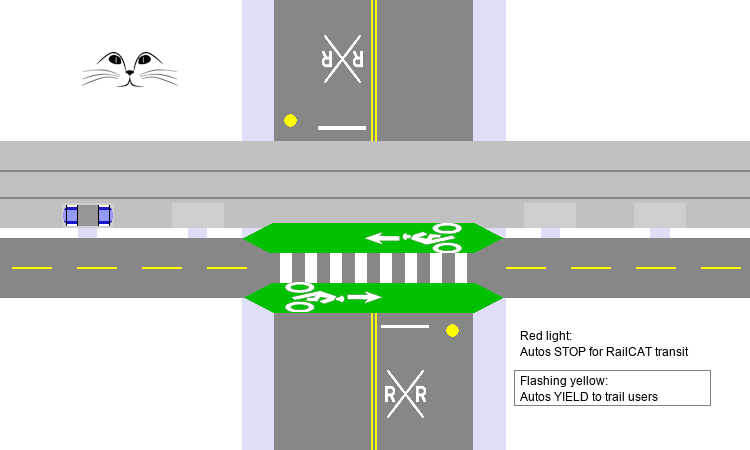This new concept was specially designed in 2022 for the Santa Cruz County Rail and Trail. It could be adapted to work well for almost any corridor that has little or no railroad traffic. It is based on a simple combination of pavement and railroad tracks co-existing in the same space. It is essentially a street with embedded railroad tracks, just like Chestnut Street and Beach Street in Santa Cruz, and Walker Street in Watsonville — but in this case, the pavement (or similar surface) would be reserved for RailCAT vehicles.

Throughout the corridor, there is a minimum 17-foot width intended for rail usage. This 17-foot width is more than enough for three lanes of narrow vehicles. That is to say, the existing space can accommodate bidirectional traffic plus passenger loading zones (CAT stops). For example, Glydways vehicles are 3.7 feet wide, designed to operate within 5-foot lanes.
We emphasize that an unlimited number of boarding locations can be located throughout the rail trail. There could be a CAT stop at every street crossing, since each CAT stop is simply a small ramp, probably with a gate and a canopy for weather protection and solar panels. Passenger waiting time is very short, perhaps a minute or two, so these loading zones don’t interfere with bicycle traffic any more than ordinary pedestrians do. Furthermore, each CAT stop can serve passengers going either direction.
We recommend for traffic signals to be installed at every railroad crossing so that pods and trail users have the right-of-way. This improves safety, especially for pedestrians and cyclists using the rail trail. The pods will be equipped with sensors and technology to respond automatically to any obstruction in the road, including wayward autos or bikes. The system should be choreographed so that the RailCAT vehicles travel together in small clusters, minimizing disruptions for automobile (and other) traffic that would be crossing the tracks.
We anticipate that automatic driving technology (and/or strategically placed dedicated lanes) in the near future will allow the system to provide direct service to key locations such as the three transit stations and Cabrillo College. See StreetCAT.
We assume that freight usage will be restricted to a few hours in the middle of the night so that the passenger transit system can operate all day and most of the night. This concept is known as “temporal separation” and is well-established for conventional passenger rail and freight. During freight usage, the CAT vehicles will move to parking lots such as the Boardwalk and Simpkins Community Center, and overhead canopies will shift if necessary to clear the railroad right-of-way.
Additional notes:
- The Glydways vehicles are currently being tested at GoMentum Station in Concord, California. A prototype of the RailCAT system could be tested locally using any available street or parking lot.
- Boarding locations can be included on both sides of the railroad tracks. They don’t all need to face the rail trail. See image below for an indication of how this might work.
- The vehicles are bidirectional, with no distinction between front and back, so turning around is simply a matter of changing direction. There is never any need for a U-turn or 3-point turn, but in some situations a RailCAT vehicle might need to wait for a break in “traffic.”
- It is our impression that most of the rail corridor has 20-foot width available, providing even more flexibility than described above. The 20-foot width is sufficient for the typical Glydways system design which uses four lanes.
- For the Rail Trail boarding locations, ADA compliance is achieved by designing the stopping zone to be approximately the same elevation as the Rail Trail, and through additional features described here.
- For a busy “station” location, the boarding zones can be ten feet apart (or whatever is the length of the vehicle), using slightly different vehicle choreography.
- This system doesn’t require stations. Conventional transit stations and benches can be installed if desired, but they are not needed because the waiting time is very short.
- “Traffic jams” don’t occur because the system is managed as a whole. In the unlikely event of vehicle failure, the remaining pods can simply go around, and the “stuck” passenger can easily transfer to another pod.
- We believe RailCAT will reduce greenhouse gas emissions by being significantly more efficient than conventional rail. See details here.

